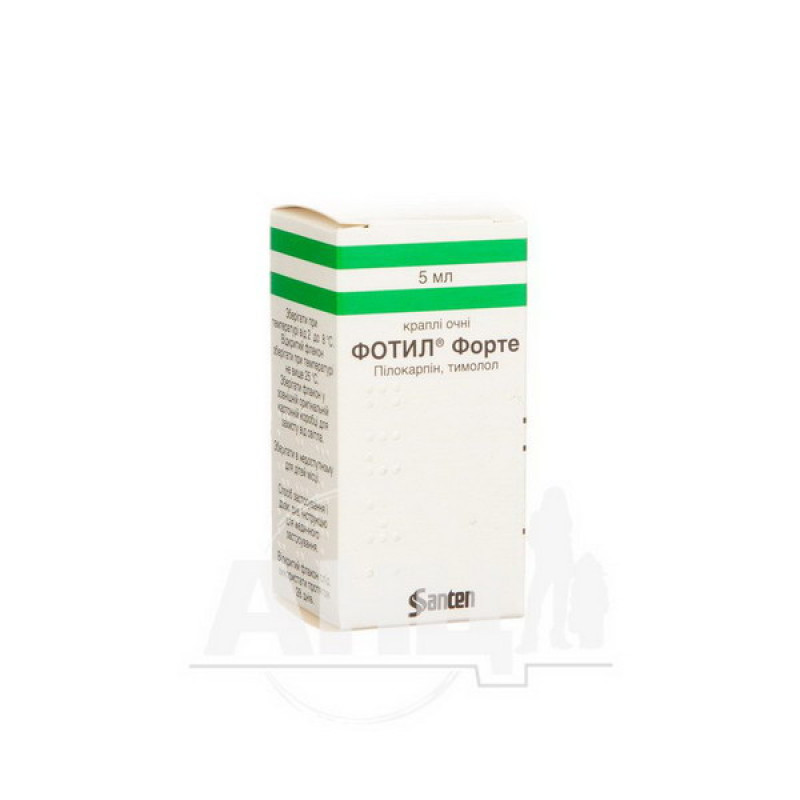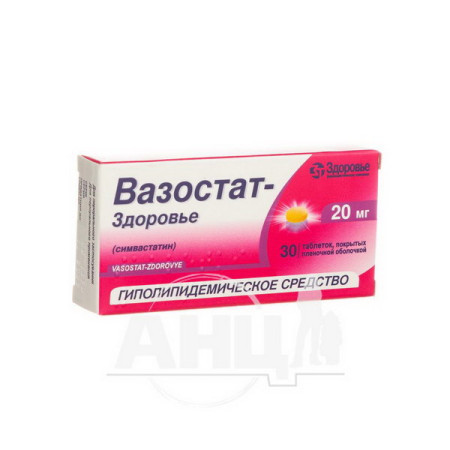Fotyl Forte eye drops dropper bottle 5 ml

Pharmacological properties
Fotil and Fotil Forte are a combination of pilocarpine and timolol - drugs that reduce intraocular pressure.
The chemical name of pilocarpine: 3 - ethyl-4 - [(1-methylimidazol-5-yl) methyl] tetrahydrofuran-2-one. It is used in the form of hydrochloride. The chemical name of timolol maleate: (S) -1- [1,1- dimethylethyl) amino] -3 [[4- (4-Morpholine) -1,2,5-thiadiazol-3-yl] -oxy] -2- propanol. (Z) -butenedioate (1: 1) salt. The structure of the compound has an asymmetric carbon atom, and the composition of Fotil eye drops includes a levorotatory compound.
Pilocarpine is a parasympathomimetic, a stimulant of M-cholinergic receptors. When instilled into the eyes, it reduces intraocular pressure, causes miosis and spasm of accommodation. A decrease in intraocular pressure is achieved by reducing the ciliary and circular muscles of the iris, which is accompanied by an increase in the angle of the anterior chamber of the eye and changes the organization of the trabecular tissue, thus facilitating the outflow of aqueous humor. When pilocarpine solution is instilled into the eye, the drug penetrates well into the cornea. Its maximum concentration in aqueous humor is reached after 30 minutes. It spreads in the tissues of the eye, the half-life from them is 1.5-2.5 hours. Spasm of accommodation and narrowing of the pupil are observed 10 minutes after instillation and persist for 1-2 hours. A decrease in intraocular pressure persists for several hours. Pilocarpine is not metabolized in aqueous humor, but is excreted with its outflow. Simultaneous use of timolol, which reduces the production of aqueous humor, reduces the rate of elimination of pilocarpine. Resorbed pilocarpine in the blood and liver tissue is hydrolyzed to inactive metabolites. The half-life from blood plasma is 30 minutes.
Timolol is a β-adrenergic receptor blocker, effectively inhibits the interaction of sympathomimetic neurotransmitters with β 1 - and β 2 -adrenergic receptors. Reduces intraocular pressure by reducing the production of aqueous humor. Acts on β 2 -adrenergic receptors of the ciliary body.
It does not have an ICA, local anesthetic (membrane stabilizing) effect, does not affect blood circulation in the retina. When instilled into the eyes, some timolol is resorbed and enters the bloodstream, through the nasolacrimal canal it enters the digestive tract, which can lead to the development of undesirable systemic effects, primarily from the cardiovascular and respiratory systems.
When administered orally, timolol is well absorbed; undergoes active presystemic metabolism. It is excreted mainly by the kidneys in the form of inactive metabolites, the half-life is approximately 4 hours. It penetrates well through the cornea. A decrease in intraocular pressure with topical application of the drug usually develops after 2 hours. The maximum effect is observed after 3-4 hours, the duration of action is 10-20 hours.
When pilocarpine and timolol are combined in one drug, an additive effect is observed in reducing intraocular pressure, since the mechanisms of action of timolol and pilocarpine are different. When applied topically, Fotil reduces both elevated and normal intraocular pressure. After instillation of Fotil, intraocular pressure usually begins to decrease after 30 minutes. The maximum effect is observed after 2 hours, and a significantly reduced level of intraocular pressure with a single administration can persist for 20 hours.
Indication
Open-angle and angle-closure glaucoma, glaucoma associated with aphakia; recently developed secondary glaucoma; as an additional agent in the treatment of glaucoma with other drugs; with increased intraocular pressure, including in the postoperative period.
Application
Usually, 1 drop of Fotil is prescribed in the affected eye(s) 2-3 times a day. Fotil Forte is prescribed 1 drop 2 times a day. Since some patients need several weeks to stabilize the drug-induced decrease in intraocular pressure, the effectiveness of Fotil should be assessed approximately 4 weeks after the start of treatment. If intraocular pressure is maintained at a satisfactory level, the dose of the drug can be reduced to 1 drop 1 time a day in the affected eye.
Increasing the dose of Fotil Forte (more than 1 drop 2 times a day) does not lead to a further decrease in intraocular pressure. If at this dose the intraocular pressure is still high, simultaneous therapy with dipivefrin and/or systemic use of carbonic anhydrase inhibitors (e.g. acetazolamide) should be prescribed.
Contraindication
Cholinergic drugs (pilocarpine) are contraindicated in acute iritis, as well as in corneal lesions. β-adrenergic blockers (timolol) are contraindicated in patients with BA or a history of it, as well as in COPD, sinus bradycardia, AV block II-III degree, severe heart failure, cardiogenic shock and hypersensitivity to any of the components of the drug.
When using eye drops containing pilocarpine, the following local adverse reactions are possible: burning sensation and acute pain, spasm of the ciliary muscle, hyperemia of the conjunctival vessels, headache in the temporal and supraorbital areas, induced myopia. Such reactions are observed, as a rule, in young people who have recently started treatment with pilocarpine. Decreased visual acuity in poor lighting is caused by miosis. When using miotics, isolated cases of retinal detachment, rigidity of the iris of the eye, and the formation of iris cysts have been noted. With prolonged use of pilocarpine, cases of reversible lens opacification have been observed. With local use of β-adrenoreceptor blockers, the following local adverse reactions have been observed: corneal anesthesia, punctate keratitis, dry eye syndrome, and allergic blepharoconjunctivitis. With prolonged use of the drug, patients with glaucoma may develop resistance to pilocarpine and timolol.
Systemic reactions may include nausea, diarrhea, increased sweating, salivation, decreased blood pressure, attacks of bronchial asthma, congestive heart failure, arrhythmia, hypotension, hallucinations, confusion, headache, asthenia, hyperemia of the nasal mucosa, rarely - depression, paresthesia and pain in the extremities, increased fatigue, anxiety, anorexia, retroperitoneal fibrosis, impotence, abdominal pain, purpura.
Special instructions
The safety and effectiveness of the drug in children have not been established.
The appointment of Fotil during pregnancy is allowed only if the expected benefit to the expectant mother outweighs the potential risk to the fetus. Given the possible serious effects of timolol on the child, the decision on whether to continue or discontinue breastfeeding should take into account the need for this drug for the treatment of the mother.
Miosis usually causes difficulty in adapting to darkness. Patients taking Fotil should be careful when driving at night. When taking oral β-adrenergic blockers simultaneously with Fotil, an additive effect may be observed on the effect on intraocular pressure or the systemic effect of β-adrenergic blockers. Fotil should also not be prescribed simultaneously with other β-adrenergic blockers used in ophthalmological practice.
Fotil and Fotil Forte should be used with caution in patients with impaired cerebral circulation. In the event of symptoms of impaired cerebral circulation, the possibility of prescribing another type of therapy should be considered. There are isolated reports that blockade of β-blockers can lead to muscle weakness caused by certain myasthenic symptoms (for example, diplopia, ptosis, general weakness). With prolonged (for several years) use of Fotil and Fotil Forte, as well as with the use of other antiglaucoma drugs, tolerance to them may develop.
The drug is capable of exerting a systemic effect after resorption up to bronchospasm in patients with bronchial asthma and heart failure. The use of Fotil should be discontinued at the first symptoms of heart failure. Fotil should not be prescribed to patients with COPD. However, if necessary, the drug should be used with extreme caution.
Fotil and Fotil Forte should also be used with caution during elective surgical procedures using anesthetic agents. It is recommended to gradually discontinue β-adrenergic blockers before surgery; this reduces the risk of hypotension and asystole during anesthesia.
Contact lenses should be removed before using the drug; they can be reinserted no earlier than 15 minutes after instillation of the drug.
Interactions
Caution should be exercised when using Fotil and calcium ion antagonists simultaneously, both when taken orally and when administered intravenously due to possible AV conduction disturbances, left ventricular failure, and hypotension. Patients with cardiac disorders should not be prescribed these drugs simultaneously.
Overdose
Overdose of parasympathomimetic agents and systemic β-blockers may cause bradycardia, hypotension, bronchospasm, and acute heart failure.
Treatment is symptomatic. Atropine is used as an antidote to pilocarpine. In case of severe bradycardia or bronchospasm, isoprenaline is administered intravenously, in case of severe hypotension, dobutamine is administered, and oxygen therapy is prescribed.
Storage conditions
In a place protected from light at a temperature of 2-8 °C; an opened vial can be stored at room temperature, the drug should be used within 1 month.
There are no reviews for this product.
There are no reviews for this product, be the first to leave your review.
No questions about this product, be the first and ask your question.







